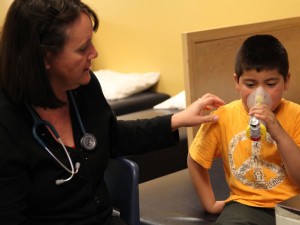The network of centers grew out of a partnership between The California Endowment, Price Charities and two well-established community clinics: La Maestra Community Health Centers and Mid-City Community Clinic.
Together, these organizations mapped out a section in San Diego's City Heights neighborhood which include a high school, two middle schools and 10 elementary schools all within walking distance from one another. From there, they created a plan to provide health coverage to every child living in the area, from birth to age 17.
Two of the schools -- Rosa Parks Elementary and Hoover High School -- already had clinics. Monroe Clark's clinic opened last year and Central Elementary School in 2010. At all the health centers, children receive medical care with no co-pay.
“We're establishing a whole system of care," said Steven Eldred, with The California Endowment. "It's not just a clinic, but schools become a point of entry to a comprehensive safety net of services.”
The health centers at Central and Monroe Clark look just like any other community clinic. Patients can be treated for the flu, minor injuries or a sudden asthma attack. But there is also a focus on preventive services including immunizations, well-baby checkups and education for patients on managing chronic conditions.
“We're trying to be proactive rather than be reactive. Once you have a disease, you have to respond and treat, but what we're trying to do is prevent disease,” said Dorothy Zirkle, director of health services for Price Charities.
Doctors and nurses team with a school nurse, who acts as a care coordinator for ailing students.
In a community like City Heights, where a large portion of the population are immigrants and refugees, the school nurse is a trusted figure who can help families navigate the health care system, according to Zirkle.
The centers become a medical home for the students and their siblings.
“You're able to invest more on patients, and you get to see them back,“ said KT Helgesen, a nurse practitioner with La Maestra Community Health Centers. “It helps build that credibility and that professional relationship with them. “
Patients also tap into mental health resources. If a nurse practitioner suspects a stomach ache or headache is related to an emotional issue, such as a troubled home life, the child is referred to a psychologist.
“Having a coordinated school health program … is about making sure a child has all aspects of their lives positively impacted,” said Andrea Karp, a psychologist with Mid-City Community Clinic.
Part of that coordinated approach includes nutrition education. A nutritionist comes to Central once a week to talk with overweight and underweight children -- as well as their families -- about food and proper exercise. At Monroe Clark Middle School, the team works with children who are obese by checking on them on a monthly basis.
Donna Magden, a school nurse at Monroe Clark, said just the presence of the clinics has made a difference.
“I think everybody is just more aware of wellness and health by having the clinic on site,” she said.
The health centers are already making an impact, advocates say. They say that attendance is up at Central since its center opened in 2010 because kids do not have to skip classes to see a doctor and instead can get immediate medical care for minor issues at the school.
"The child spends less time missing school and spends a lot more time in the classroom," said Helgesen.
Putting health clinics at schools is not a new phenomenon. But their role as a safety net in some communities is growing.
In late 2012, the U.S. Department of Health and Human Services announced the release of $80 million to school-based health center programs across the country. An additional clinic will be added within the 13-school cluster in City Heights by the end of 2013.
Marnette Federis is a freelance writer living in San Diego.
